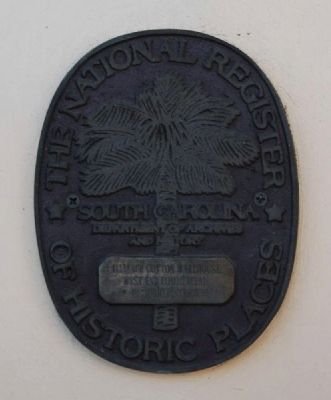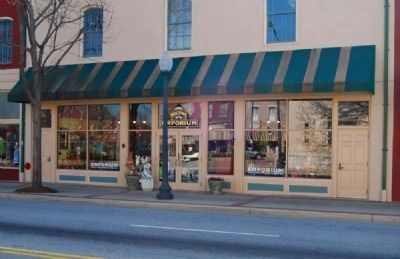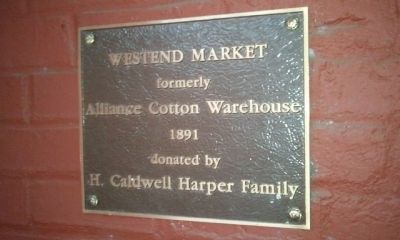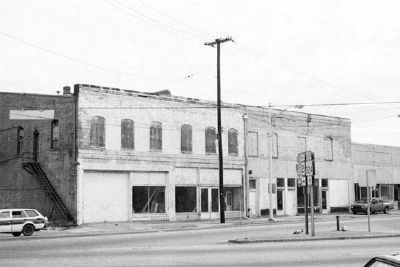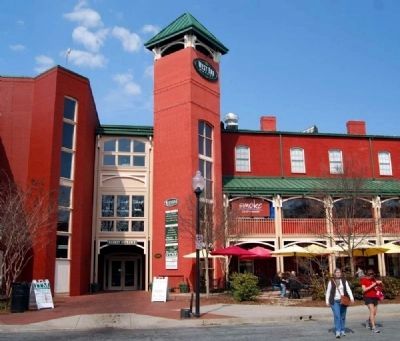Greenville in Greenville County, South Carolina — The American South (South Atlantic)
Alliance Cotton Warehouse
West End Commercial Historic District
of Historic Places:
Alliance Cotton Warehouse
West End Commercial
Historic District
Erected 1993.
Topics. This historical marker is listed in this topic list: Notable Buildings.
Location. 34° 50.633′ N, 82° 24.25′ W. Marker is in Greenville, South Carolina, in Greenville County. Marker is on Augusta Street (State Highway 20) south of Pendleton Street, on the left when traveling south. Touch for map. Marker is at or near this postal address: 1 Augusta Street, Greenville SC 29601, United States of America. Touch for directions.
Other nearby markers. At least 10 other markers are within walking distance of this marker. Mills & McBayer Cotton Warehouse (within shouting distance of this marker); Wilson Cooke (about 500 feet away, measured in a direct line); Greenville Arboretum (about 500 feet away); The Touchstone House "Falls Cottage" (about 600 feet away); The Touchstone House (about 700 feet away); Chicora College (about 700 feet away); Restoration and Development (about 800 feet away); Falls Cottage (about 800 feet away); Dr. Charles Hard Townes (about 800 feet away); Harriet Smith Wyche (approx. 0.2 miles away). Touch for a list and map of all markers in Greenville.
Also see . . .
1. West End Commercial Historic District . The West End Commercial Historic District is significant as Greenville’s second "downtown," with historic resources dating from ca. 1869 to ca. 1939, the majority of which date from the 1880s to the 1920s, a period of extensive development in the area. (Submitted on March 6, 2010, by Brian Scott of Anderson, South Carolina.)
2. Farmers' Alliance. The Farmers' Alliance was an organized agrarian economic movement amongst U.S. farmers that flourished in the 1880s. (Submitted on March 6, 2010, by Brian Scott of Anderson, South Carolina.)
Additional commentary.
1. Alliance Cotton Warehouse - West End Commercial Historic District Nomination Form
1891 two-part commercial block, brick warehouse. Built by the Farmers' Alliance at a cost of $3,750.00. Notable features include two remaining segmental-arched windows; shared wall and foundation with adjacent Mills and McBrayer Warehouse; low-pitched lateral gable. Used as a bowling alley and for storage.
— Submitted March 6, 2010, by Brian Scott of Anderson, South Carolina.
2. Farmers' Alliance Cotton Warehouse
One of the earliest surviving cotton warehouses in Greenville today is a brick two-story
cotton warehouse dating to 1890 within the present structure (the facade is later). Jacob Cagle, one of the most important local builders in the late nineteenth century, was in the midst of adding a cupola to Robert Mill's old courthouse (by then the Records Building) at Court square when he received the commission from the Farmers' Alliance to build this new cotton warehouse. Greenville's textile industry was taking off and the demand for cotton in the local mills was heavy. Fortunately, cotton didn't have to travel far to supply the city's demand. When the Farmers' alliance warehouse was built, Greenville County was producing nearly thirty thousand bales per year. Nine mills were in operation, including Pelham Mill, Batesville Manufacturing, Reedy River Manufacturing, Huguenot Mill and the mighty Piedmont Manufacturing Company. (Source: A Guide to Historic Greenville, South Carolina by John M. Nolan (2008), pg 40.)
— Submitted March 6, 2010, by Brian Scott of Anderson, South Carolina.
3. West End Commercial Historic District - National Register Nomination Form
The West End Commercial Historic District is significant as Greenville's second "downtown," from c. 1869 to c. 1939. Located south of the Reedy River, major commercial development began after the Civil War near Furman University and the Greenville and Columbia Railroad depot. By the 1800s the first block of Pendleton Street was a flourishing commercial area. To the north, Chicora College (1893-1915), a Presbyterian school for women, was established on "McBee's Terrace" overlooking the Reedy River. South Main Street from modern-day Camperdown Way south to River Street developed following World War I, after Chicora burned in 1919 and its former property was commercially developed. The West End District is architecturally significant for its notable examples of Victorian commercial buildings on the first block of Pendleton Street and for its 20th century commercial buildings along South Main Street.
The first development of Greenville's West End began in the early 1850s, when Furman University was built (1852) on a bluff overlooking the Reedy River, and the Greenville and Columbia Railroad established (1853) its terminus on Augusta Street near present-day Greenville High School. Commercial development began just prior to the Civil War, when a hotel and several general stores were built nearby.
After the Civil War, cotton became an important crop in Greenville County. The first bales were sold in the West End of Greenville in 1867, when phosphate and guano fertilizers made production commercially profitable in the upcountry. The West End prospered with cotton: the Camperdown,
Huguenot, and Vardry Mills were established in or near the West End; a cotton seed oil company began; cotton warehouses and platforms for weighing the crop were built in the 1870s and 1880s near the railroad tracks. New stores sold groceries, farm supplies, and dry goods to farmers, Furman students, and to the increasing number of merchants and workers at nearby river front industries, as well as to the residents of Augusta, Pendleton, and River Streets.
The West End was prosperous, solid, and growing by the early 1890. Chicora College was built on the site of Alexander McBee's former homeplace, the block now bordered by River, Rhett, Main, and Camperdown Streets; the American Bank was established in a renovated 1877 drug store at the intersection of Pendleton and Augusta Streets (1890); and the Farmers' Alliance established the Alliance Cotton Warehouse (1891) and Mills and McBrayer built an adjoining warehouse so that farmers could hold their cotton back from the market in times of falling prices. About one-third of Greenville's residents lived nearby, and they even began talk of incorporating the area across the river as a separate town. Church congregations began to form (Second Presbyterian in 1893, St. Andrew's Episcopal in 1900, St. Paul's Methodist in 1897, and Second Baptist, later Pendleton Street Baptist, in 1889). A West End School was built in 1888; Furman was enlarged in the early 1890s; telephone, telegraph, water systems, and trolley service came to the fashionable residential neighborhoods further south on Augusta and Pendleton Streets.
After the turn of the century, textile mills were generally erected outside Greenville's northwestern city limits, and inner-city mills declined. Freight rates increased and cotton profits diminished. Chicora College moved from Greenville to Columbia in 1915, and its buildings burned in 1919. At first there was little impact from these changes: new service industries such as automobile sales and repairs and soft drink manufacturing grew in importance after 1910; the Chicora property was almost immediately redeveloped for small automobile-related businesses. American Bank built an impressive new building (1920) on its old site, and its directors formed the American Building and Loan Company in 1921. In the 1920s, however, the West End was increasingly overshadowed by commercial growth in downtown Greenville. West End businesses attracted nearby farmers and residents of surrounding mill villages while more well-to-do shoppers patronized downtown stores. New and more prestigious residential areas were developed in the northern part of the city. Although a number of blacks had lived in the West End area in the nineteenth century, after 1920 many more began to occupy former single-family
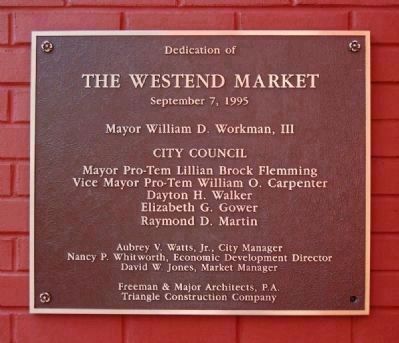
Photographed By Brian Scott, March 8, 2010
6. West End Dedication Plaque -
Located Near the Southern Entrance
Located Near the Southern Entrance
The Westend Market
September 7, 1995
Mayor William D. Workman, III
City Council
Mayor Pro-Tem Lillian Brock Flemming
Vice Mayor Pro-Tem William O. Carpenter
Dayton H. Walker
Elizabeth G. Gower
Raymond D. Martin
Aubrey V. Watts, Jr., City Manager
Nancy P. Whitworth, Economic Development Director
David W. Jones, Market Manager
Freeman & Major Architects, P.A.
Triangle Construction Company
By the late 1930s, the West End had become a stagnant neighborhood, with almost no new building and little renovation of existing properties. Farmers and mill workers still shopped in its furniture, grocery, and dry goods stores, and Furman students patronized its cafes and pharmacies, but the community was declining. After the boll weevil and years of agricultural depression, cotton was no longer a profitable crop; prosperity disappeared with agricultural depression. The American Building and Loan (renamed Fidelity Federal in 1936) moved across town in 1939, marking the end of the West End as a viable commercial district.
After World War II, West End residential areas declined drastically, to be replaced by warehouses, distribution centers, and light industrial businesses. Crime increased and prostitutes frequented tawdry hotels. Old landmarks and focal points were tom down and redeveloped: Furman University moved to a new location in 1958 and was replaced by a shopping mall. The cotton seed oil mill was replaced by a four story medical office building, and the old freight depot by a large lumberyard. The stock of old commercial buildings, however, remained. They were either occupied by low-rent retail establishments and new service businesses or were boarded up and remained vacant. Only a few were torn down, or fell down over the decades.
In the 1980s major renovations in the West End began, and in the 1990s rehabilitations are anticipated to accelerate, resulting in a number of adaptive uses for Greenville's largest collection of intact turn-of-the century (1880-1920) commercial buildings.
— Submitted March 6, 2010, by Brian Scott of Anderson, South Carolina.
Credits. This page was last revised on November 16, 2020. It was originally submitted on March 6, 2010, by Brian Scott of Anderson, South Carolina. This page has been viewed 1,690 times since then and 43 times this year. Photos: 1, 2. submitted on March 6, 2010, by Brian Scott of Anderson, South Carolina. 3. submitted on August 20, 2011, by Tony Moore of Simpsonville, South Carolina. 4. submitted on March 6, 2010, by Brian Scott of Anderson, South Carolina. 5, 6. submitted on April 19, 2010, by Brian Scott of Anderson, South Carolina.
